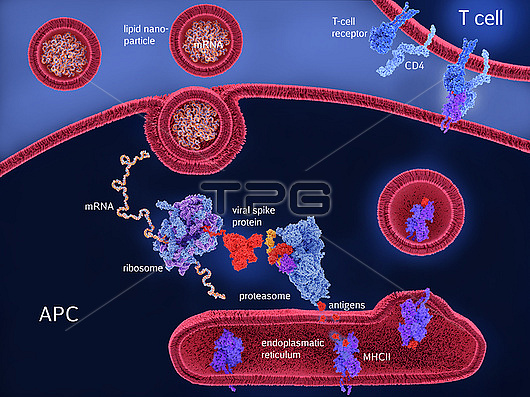
Illustration of the mechanism by which the Covid-19 RNA (ribonucleic acid) vaccine induces immunity. The vaccine consists of strands of mRNA (messenger ribonucleic acid) encased in a lipid nanoparticle sphere (top left). The mRNA codes for a mutated version of the viral spike protein found on the surface of the SARS-CoV-2 coronavirus that causes Covid-19. When injected into the body the mRNA (multicoloured strand) is taken up by the body's cells (dark blue), ribosomes read the mRNA and manufacture copies of the protein (bright red). Major histocompatibility complex (MHC) molecules (blue and violet) display the proteins on the cell's surface. This stimulates an immune response, causing the body to produce antibodies and T cells (top right) against the spike protein. This means that the body is primed to attack the virus should it be encountered after vaccination, preventing disease. The first RNA vaccine approved for human use, developed against the SARS-CoV-2 coronavirus by Pfizer/BioNTech, was approved in the UK on 2nd December 2020.
| px | px | dpi | = | cm | x | cm | = | MB |
Details
Creative#:
TPG32183162
Source:
達志影像
Authorization Type:
RF
Release Information:
須由TPG 完整授權
Model Release:
N/A
Property Release:
N/A
Right to Privacy:
No
Same folder images:

 Loading
Loading